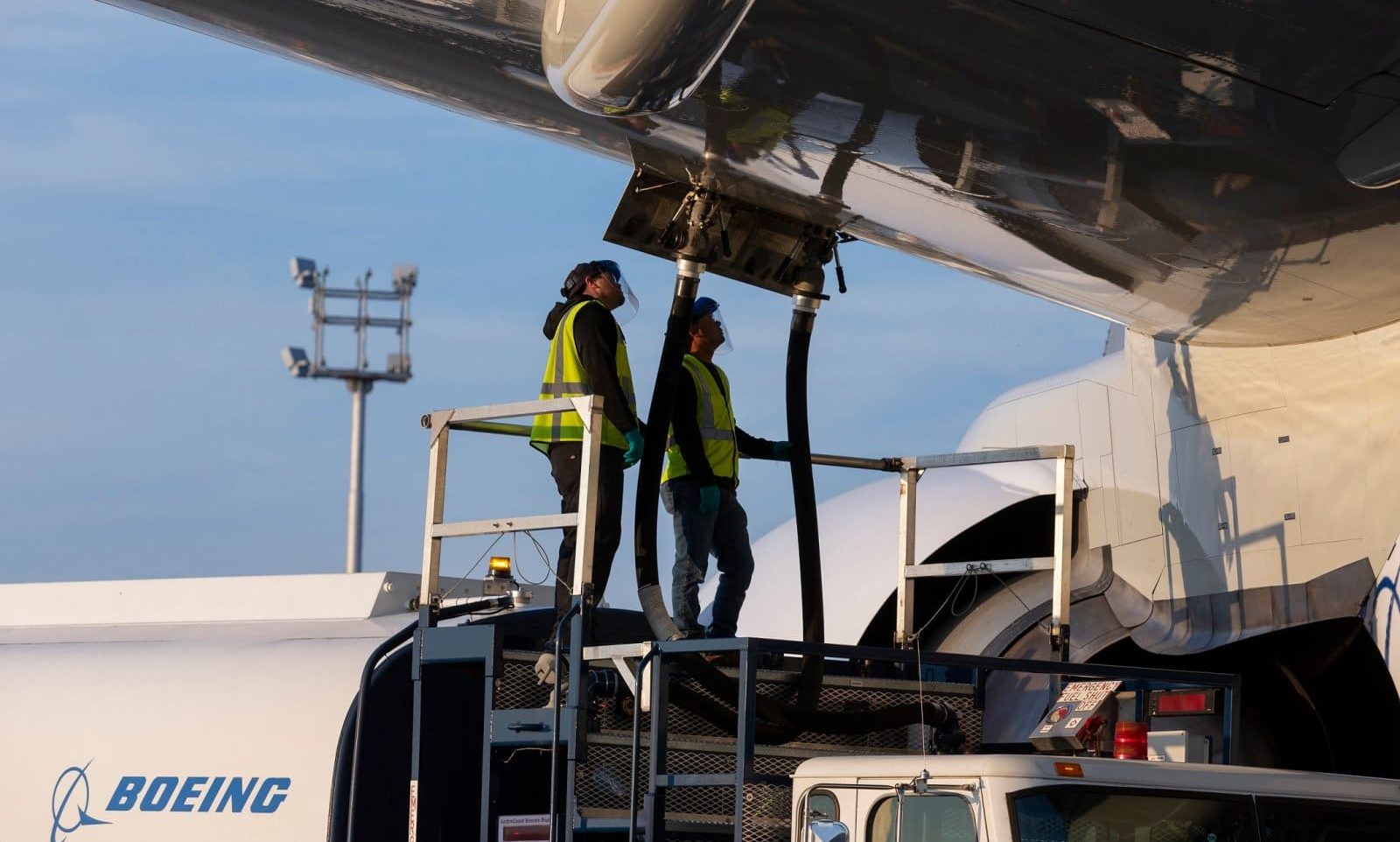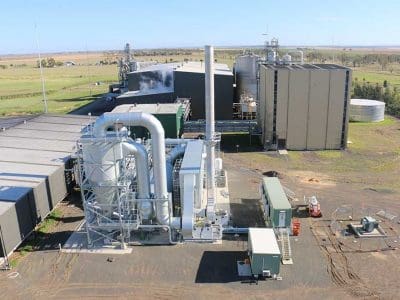
Sustainable Aviation Fuel (SAF) being pumped into Boeing’s ecoDemonstrator. Photo: Boeing
TOOWOOMBA’S Wagner Sustainable Fuel and global aerospace company Boeing have partnered to develop a sustainable aviation fuel facility within the Wellcamp Airport precinct.
A part of the Wagner family’s group of companies, WSF has commenced the design and construction of Australia’s first steady supply of SAF within the airport’s fuels precinct to blend SAF to international aviation regulations.
SAF is a renewable energy source produced from renewable materials, such as agricultural waste, animal fats, canola and vegetable oils, and municipal solid waste.
WSF chief executive officer Matt Doyle said the agreement was a major step forward in the company’s goal of reducing Australia’s hard-to-abate sectors of aviation and heavy transport through the supply and facilitation of SAF and Renewable Diesel.
“In collaboration with Boeing, the Wellcamp blending facility will demonstrate the greenhouse gas emissions reduction benefits of SAF for our customers, provide a focus for federal and state policy makers and introduce the supply chain to this potential AUD$3 billion-plus per year industry,” Mr Doyle said.
“We’re proud to contribute to the building blocks of a sovereign SAF production industry with this Australian-first facility and anticipate by the end of 2024, this facility will mark the start of the supply of SAF in Australia on a consistent basis.”
Boeing Australia, New Zealand & South Pacific sustainability lead Kim Camrass said the collaboration will help meet Australia’s airline demand for jet fuel, which is expected to increase by 75 percent over the next 25 years.
“Wagner’s sustainability goals align with Boeing’s work to advance aviation decarbonisation and energy security through renewable energy including SAF, advanced technologies, operational efficiency, and fleet renewal,” Ms Camrass said.
Feedstock opportunities
It is unclear what type of SAF the company will be producing; however, based on previous comments, WSF, will most likely be using the alcohol-to-jet process.
This is different to other methods, such as the Hydroprocessed esters and fatty acids (HEFA) process which creates SAF using oilseeds, tallow or used cooking oils.
The alcohol-to-jet method processes agricultural residues or sugarcane into ethanol before turning it into SAF.
Although Australia currently produces ethanol from molasses and wheat starch, the CSIRO in its SAF Roadmap published in August 2023 identified sorghum, sugar and bagasse as potential additional feedstocks.
Agricultural residues such as those from grain and rice crops could also be a viable feedstock.
The report stated that by 2025, the top two feedstocks for SAF production in Australia will be agricultural residues and a combination of sugarcane and bagasse.
In his speech at the Australian Renewable Fuels Week conference held in Brisbane in May 2023, Mr Doyle, then the energy and sustainability lead at Wagner Corporation, said the company was focused on making large-scale SAF production a reality for Australia.
“We are really looking to take our business to carbon zero or climate positive.
“It has given us a good focus on SAF and what we have to do to advance the industry.
“We are really trying to get involved and work out how we can assist, how we can play a part.”
Mr Doyle said the company was working on finding the best feedstock to fit the plant’s location and needs.
“We have done a look of work in studying the different feedstocks.
“There’s a range of feedstocks that are coming into play.
“Second generation is coming through with sugarcane, and around where we are, there is a lot of sorghum so there is a lot of potential to put a plant at Wellcamp.”
He said there were challenges with creating new supply chains and industries, but the environmental and economic payoff would be substantial.
“By 2024 we are at 9.4 billion litres of Jet-A1, going up to 14B by 2050.
“There’s a real fantastic opportunity for us to introduce SAF into that market.
“There’s an enormous economic opportunity, $2.8B by 2030 and $7.6B by 2050.
“We’re doing what we can to implement that.”
Ms Camrass said the aviation industry would need to collaborate with other sectors and government to achieve its greenhouse gas-emission goals.
“We’re working closely with the Australian Government’s Jet Zero Council to overcome the challenges required to build a domestic SAF industry, such as feedstock availability, supply chain constraints and aligning to international standards.”
The project is one of two underway in Australia with clear plans to produce SAF.
The other is a project led by Jet Zero Australia, a venture capital company backed by Qantas, Airbus and Idemitsu, which is progressing plans to construct an alcohol-to-fuel facility at Townsville.
It will mostly use locally produced feedstocks, such as sugarcane waste.
Dalby Bio-Refinery questions
WSF has opted to build a new facility instead of utilising the closed Dalby Bio-Refinery site, located about an hour away from the Wellcamp airport.
The plant used sorghum to produce industrial-grade ethanol to be blended into unleaded petrol for use by Australian motorists.

United Ethanol’s Dalby Bio-Refinery closed in mid-2020.
Owned by United Petroleum, the Dalby Bio-Refinery closed in February 2020 but was then re-opened in April to increase the local manufacturing of hand sanitiser, hand wash and surface disinfectants.
The plant shutdown for good in June that year around claims the Queensland Government and other manufacturers failed to source ethanol from the site to use in cleaning products.
The SAF Roadmap, which was co-authored by Boeing, recommended that the Dalby Bio-Refinery by re-opened as a medium-term goal (2025-2035).
“If [alcohol-to-jet] is to be effectively scaled, Australia would need to increase ethanol production significantly,” the report said.
“Maximising output at current ethanol plants, re-opening the Dalby refinery and exploring options for new centralised and distributed ethanol plants will be necessary.”
The report estimated Australia’s current ethanol capacity at 360 million litres, derived from two facilities: Manildra Group’s Nowra site and Wilmar at Sarina, near Mackay.
However, as of 2022, the plants were only operating at 57pc capacity.
CSIRO said Dalby could add another 80 million litres of capacity to Australia’s ethanol production.
“Increasing the capacity of the existing plants and reopening the Dalby refinery presents a promising opportunity to boost local ethanol production for ATJ facilities in the near term.”
It is unclear whether the Dalby facility could be re-opened if there was increased demand from the aviation industry.
According to an IPART report published in September 2021, the Dalby facility had not be disassembled and “could potentially be restarted if market conditions and prices continue to improve”.
Grain Central: Get our free news straight to your inbox – Click here

HAVE YOUR SAY